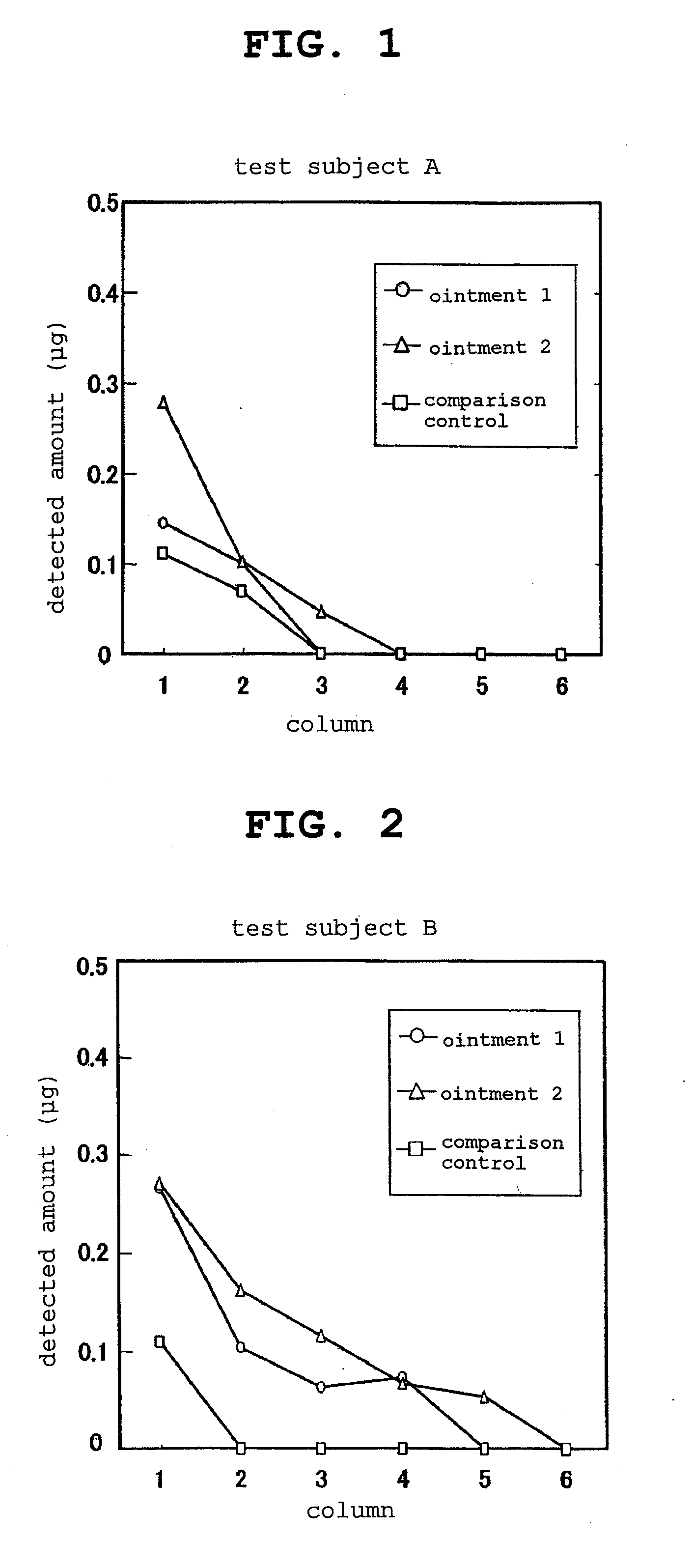Preparation for external application comprising salt of mast cell degranulation inhibitor having carboxyl group with organic amine
- Summary
- Abstract
- Description
- Claims
- Application Information
AI Technical Summary
Benefits of technology
Problems solved by technology
Method used
Image
Examples
example 1
Formation of Salt of Mast Cell Degranulation Inhibitor and Organic Amine
[0068]Using tranilast and cromoglycic acid Na as mast cell degranulation inhibitors and triisopropanolamine as an organic amine, a 1:1 salt was formed (formation of ionic liquid) as in the following.
(1) Formation of Salt of Tranilast and Triisopropanolamine
[0069]Tranilast (0.50 g) and triisopropanolamine (0.29 g) were weighed, and the both compounds were melted by heating in a flask at 80° C. for 30 min. The molten liquid remained viscous even at room temperature.
[0070]IR absorption of the carboxyl group of tranilast appears at a position of 1690 (1 / cm−2) when measured by a KBr method. On the other hand, the IR absorption of the molten viscous liquid was measured to find that the absorption at 1690 (1 / cm−2) corresponding to the carboxyl group had disappeared. In addition, as a new IR absorption, absorption at a position of 1585 (1 / cm−2) had increased. IR of the obtained molten salt was measured using NaCl cell d...
example 2
Formation of Salt of Tranilast and Various Organic Amine Compounds and its Solubility in Ester Compound
[0075]Test solutions containing tranilast were prepared according to the formulations shown in Table 1 (wt %, diethyl sebacate as a balance to set the whole to 100 wt %; in the following, the “balance” refers to wt % of each substance added to set the whole to 100 wt %), and the solubility of organic amine salt of tranilast in diethyl sebacate was examined. The organic amine compound added for salt formation was added at a ratio of 2 mol per 1 mol of tranilast. As comparison example 1, the solubility of tranilast in diethyl sebacate was examined.
TABLE 1testtesttesttestsolutionsolutionsolutionsolutionComp.1234Ex. 1tranilast11111monoethanolamine0.37diethanolamine0.64triethanolamine0.9triisopropanolamine1.16diethyl sebacatebalancebalancebalancebalancebalance(numerical values are in wt %)
[0076]For evaluation of the solubility of tranilast in diethyl sebacate, the mixture was stirred at...
example 3
Formation of 1:1 Salt of Tranilast and Triisopropanolamine and its Solubility of Salt in Various Solvents
[0080]For preparation of test solutions (blending corresponding to 1 mol of triisopropanolamine), tranilast (1 wt %) and triisopropanolamine (0.56 wt %) were added, and glycerol, propylene glycol, butylene glycol, salicylic acid ethylene glycol, diethyl sebacate and isopropyl myristate were used as a balance to achieve 100 wt %, whereby each test solution was prepared.
[0081]For preparation of comparison control (without triisopropanolamine), tranilast (1 wt %) was added, and propylene glycol, salicylic acid ethylene glycol, diethyl sebacate and isopropyl myristate were used as a balance to achieve 100 wt %, whereby each test solution was prepared.
[0082]Using the test solutions and comparative controls prepared above, the solubility of tranilast in various solvents with or without triisopropanolamine was examined.
[0083]The results are shown in the following Table 3 (difference in ...
PUM
| Property | Measurement | Unit |
|---|---|---|
| Fraction | aaaaa | aaaaa |
| Fraction | aaaaa | aaaaa |
| Fraction | aaaaa | aaaaa |
Abstract
Description
Claims
Application Information
 Login to View More
Login to View More - R&D
- Intellectual Property
- Life Sciences
- Materials
- Tech Scout
- Unparalleled Data Quality
- Higher Quality Content
- 60% Fewer Hallucinations
Browse by: Latest US Patents, China's latest patents, Technical Efficacy Thesaurus, Application Domain, Technology Topic, Popular Technical Reports.
© 2025 PatSnap. All rights reserved.Legal|Privacy policy|Modern Slavery Act Transparency Statement|Sitemap|About US| Contact US: help@patsnap.com

